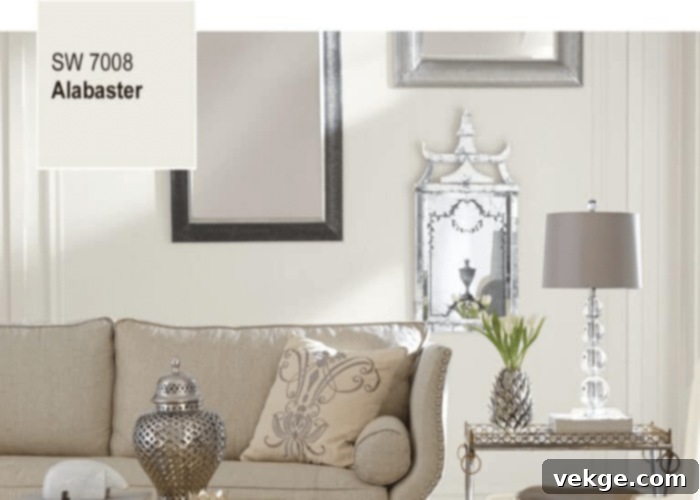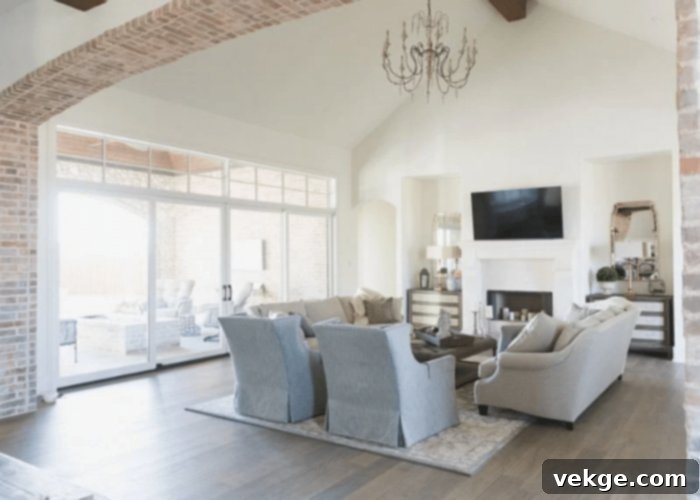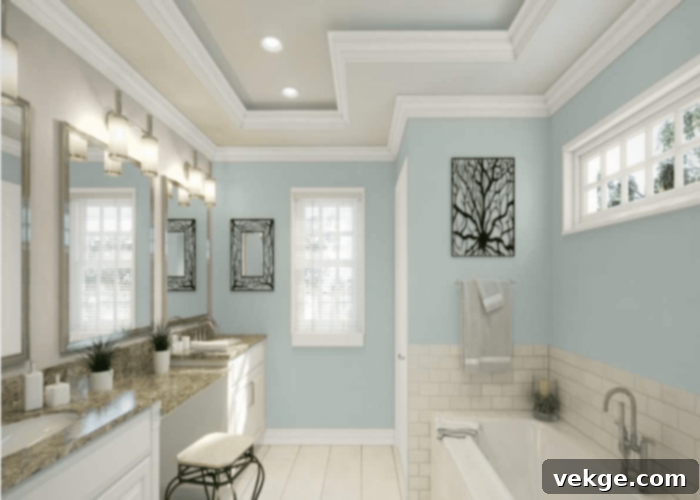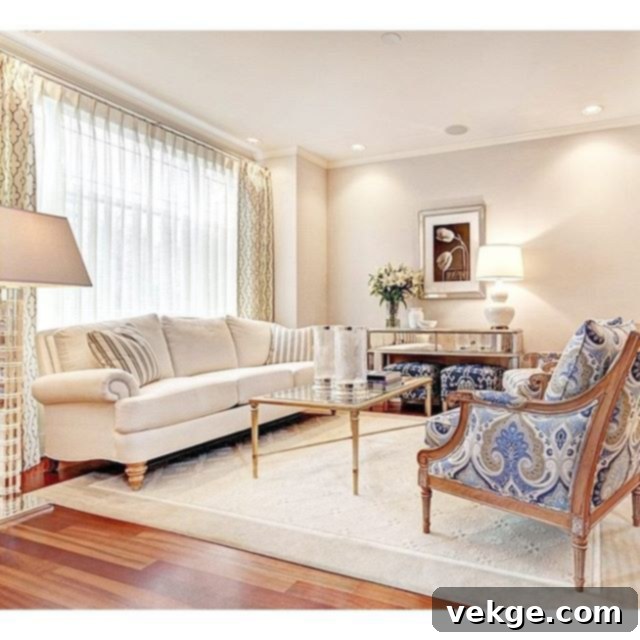Sherwin Williams Alabaster Living Room Ideas: A Complete Guide to Using SW 7008 for Walls, Accents & Trim
For enthusiasts of serene, neutral aesthetics and the renowned quality of Sherwin-Williams paint colors, one shade consistently emerges as a fan favorite: Sherwin Williams Alabaster (SW 7008). Crowned as the Sherwin-Williams Color of the Year in 2016, this exquisite off-white has steadily grown in popularity, becoming a staple in modern interior design. If you’re contemplating its use in your living room, you’re not alone. The question often arises: how can this versatile hue be best utilized to create a truly stunning and cohesive space?
Worry not! This comprehensive guide is designed to illuminate the unique characteristics of Sherwin Williams Alabaster and provide a wealth of tips and creative ideas for incorporating it into your living room. From its foundational role on walls to its subtle yet impactful application as accents and trim, we’ll explore how Sherwin Williams Alabaster can elevate your home’s aesthetic. Keep reading to unlock the full potential of this timeless color.
Whether you envision it as the primary backdrop or as a refined detail, Alabaster’s compatibility with a spectrum of neutral and soft colors makes it an ideal choice for crafting a welcoming and elegant living environment. In the following sections, we will delve into practical applications, including its sophisticated use for living room accents and trim, ensuring your design vision comes to life beautifully.
Understanding Sherwin Williams Alabaster (SW 7008)

Before diving into design applications, it’s essential to grasp what makes Sherwin Williams Alabaster so special. Identified by the code SW 7008, this shade is far more than just a simple white. It’s a beautifully nuanced, warm off-white that strikes a perfect balance between crisp brightness and inviting softness. Its Light Reflective Value (LRV) is 82, a significant characteristic that positions it as a white with considerable depth, rather than a stark, blinding hue. An LRV of 82 means it reflects a high percentage of light, making rooms feel larger and brighter, yet its inherent warmth prevents it from appearing cold or clinical.
The magic of Alabaster lies in its subtle undertones. Unlike cooler whites that lean towards blue or gray, Alabaster possesses gentle beige or greige undertones. These soft undertones are crucial; they imbue the color with a creamy, comforting quality, preventing it from ever looking yellow or too stark. This makes it incredibly versatile, adapting beautifully to various lighting conditions and design styles, from modern farmhouse to coastal chic or minimalist contemporary.
As a celebrated neutral, this color brings an atmosphere of mindfulness and personal solace, making it an ideal choice for spaces where relaxation and tranquility are paramount, such as the living room. Its compatibility with a broad spectrum of colors, particularly soft, earthy, and other neutral tones, allows it to seamlessly integrate into almost any decor scheme. Whether you’re aiming for a cohesive monochromatic look or seeking a gentle contrast, Sherwin Williams Alabaster serves as an elegant foundation for any living room design.
Alabaster on Living Room Walls: A Foundation of Warmth
One of the most popular and impactful ways to utilize Sherwin Williams Alabaster is as the primary color for your living room walls. Its warmth and subtle depth provide a comforting embrace, instantly making the space feel more inviting and cozy. As a foundational color, Alabaster excels at creating a soft, luminous backdrop that enhances natural light and makes other design elements—like furniture, artwork, and textiles—truly pop without being overwhelmed.
The beauty of using SW 7008 on walls lies in its ability to adapt. In rooms bathed in natural light, it appears as a bright, airy white, reflecting light beautifully and opening up the space. In areas with less natural light or during evening hours, its inherent warmth becomes more pronounced, creating a rich, creamy glow that feels utterly welcoming. This adaptability ensures that your living room maintains a consistent, appealing ambiance throughout the day, always feeling fresh yet never stark.
Many homeowners choose Alabaster for walls as a sophisticated alternative to starker whites. It offers the brightness of white but with an added layer of softness that promotes relaxation and comfort. It’s the perfect choice for creating a serene retreat where you can unwind and entertain, blending effortlessly with various materials like natural wood, stone, and metals, and serving as an ideal canvas for any decorative style.
Sherwin Williams Alabaster as Captivating Accents

Beyond its dominant role on walls, Sherwin Williams Alabaster shines brilliantly when used as an accent color. Its gentle nature allows it to highlight architectural features or decorative elements without overpowering the main palette, offering a subtle contrast or a harmonious blend depending on your existing colors. Here are several ways to incorporate this beloved hue as a captivating accent in your living room:
1. Pattern Stripes and Stenciling
If your living room walls are painted in bolder colors, deep grays, or even a different neutral, Alabaster can introduce a beautiful, slight contrast through stripes or patterns. Consider a feature wall where thin or wide vertical stripes in Alabaster create an elegant, architectural detail. This approach can add visual interest and a sense of height to a room. Alternatively, delicate stenciled patterns in Alabaster on a colored wall can provide a sophisticated, textured look, particularly effective in alcoves or behind shelving units. You can also apply this technique to the interior panels of your living room windows or doors for an unexpected touch of definition.
2. Accessories and Hardware Accents
Infusing Sherwin Williams Alabaster into your metallic items and furniture hardware is an excellent way to introduce subtle touches of this elegant off-white. Consider painting wooden or even certain metal furniture handles, cabinet knobs, or mirror frames in this refined shade. This creates a cohesive look that ties together different elements in the room. For decorative items, think about painting the base of a lamp, the caps of light fixtures, or a vintage chandelier with Alabaster. These small details contribute significantly to the overall aesthetic, adding a touch of understated luxury.
Beyond painted surfaces, textiles offer another avenue for Alabaster accents. Incorporate this versatile color through throw pillows, blankets draped over sofas, or even subtle patterns within curtains or area rugs. A collection of throw pillows in varying textures but unified by Alabaster creates a soft, inviting layered look. Furthermore, antique pieces or unique decorative items can be given a fresh lease on life by being painted in Alabaster, allowing them to flaunt their form and intricate details while seamlessly blending with a modern color scheme.
3. Art Pieces and Gallery Walls
Art provides a sophisticated means to introduce Sherwin Williams Alabaster into your living room. You might select artwork where Alabaster is a prominent color in the theme, perhaps in abstract compositions or serene landscapes. Another impactful way is to use frames painted in Alabaster. A single large piece framed in this warm white can become a focal point, drawing the eye and adding brightness. For a more extensive display, curate a gallery wall where all the frames are unified by the serene hue of Alabaster. This not only highlights the art but also creates a cohesive and elegant display, allowing the different pieces to tell a unified story within your space.
Sherwin Williams Alabaster for Elegant Trims

Utilizing Sherwin Williams Alabaster for your living room trims is a fantastic way to achieve a clean, cohesive, and sophisticated look. Trim, molding, and architectural details define the structure of a room, and painting them in Alabaster can either create a subtle, monochromatic flow with Alabaster walls or provide a soft, elegant contrast against darker or colored walls. This approach adds a refined finish, enhancing the architectural integrity of your space. Even patterns in fabrics can subtly echo the Alabaster trim look, creating visual harmony.
1. Ceiling Exposed Beams and Crown Molding
If your living room features exposed ceiling beams, painting them in SW Alabaster can dramatically lighten and brighten the overhead space. This is particularly effective if your walls or ceiling are in a contrasting, darker, or richer color, allowing the beams to stand out as architectural highlights. Similarly, crown molding, baseboards, and other ceiling details painted in Alabaster provide a crisp boundary that elegantly frames the room, drawing the eye upwards and enhancing the perceived height of the space.
2. Window Frames and Doors
Doors and window frames offer an excellent opportunity to introduce the magic of SW Alabaster as trim. Painting these elements in Alabaster provides a crisp, clean border that beautifully frames views to the outside and defines entryways. Whether your walls are Alabaster or another color, using this warm white on the casings and sills creates a polished and inviting look. It also helps maximize the feeling of natural light entering the room, making windows appear larger and more prominent.
3. Gallery Art Wall Trim
As mentioned in the accents section, extending the use of Alabaster to the trim of a gallery art wall can create a truly unified and impactful display. Painting the molding or shelving that frames your collection in SW Alabaster ensures that the architectural elements support rather than distract from the art. This detail brings a refined, gallery-like quality to your living room, where every piece feels thoughtfully integrated.
4. Curtains and Furniture Cover Trims
For a softer application of Alabaster trim, consider incorporating it into your textiles. Curtains with Alabaster borders, piping, or subtle patterns can tie into the room’s color scheme, especially if your walls or other trims are also in this shade. Similarly, furniture covers or slipcovers featuring Alabaster trim, decorative piping, or contrast stitching introduce the color in a gentle, textural way, contributing to a cohesive and layered aesthetic without adding more painted surfaces.
Complementary Colors and Textures for Sherwin Williams Alabaster
One of Alabaster’s greatest strengths is its ability to harmonize with a wide array of other colors and textures. To enhance its natural warmth and create a well-rounded living room, consider pairing it with:
- Soft Grays and Greiges: For a sophisticated, modern palette.
- Warm Wood Tones: Natural oak, walnut, or lighter pine furniture and flooring bring out Alabaster’s creamy undertones.
- Muted Greens and Blues: Sage green, dusty blue, or serene teal can add a calming, natural element.
- Earthy Browns and Terracottas: For a grounding and organic feel, particularly in accessories or accent pieces.
- Metallics: Brushed brass, matte gold, or oil-rubbed bronze hardware and lighting fixtures provide a touch of elegance.
In terms of textures, Alabaster beautifully complements natural materials. Think linen drapes, wool throws, velvet cushions, rough-hewn wood furniture, woven jute rugs, and ceramic decor. Layering these textures against an Alabaster backdrop adds depth and interest, creating a living room that is rich in character and incredibly inviting.
Tips for Decorating with Sherwin Williams Alabaster
To ensure your living room truly shines with Sherwin Williams Alabaster, keep these practical tips in mind:
- Always Test Swatches: Paint a sample on a large piece of poster board and observe it in your living room throughout the day, under different lighting conditions. Alabaster’s appearance can shift subtly depending on natural and artificial light.
- Consider Your Room’s Light Exposure: In north-facing rooms, Alabaster’s warmth helps counteract cooler light. In south-facing rooms, it will appear brighter and lighter.
- Vary Sheen Levels: Use a flat or matte finish for walls to achieve a soft, velvety look. For trim and doors, opt for a satin or semi-gloss finish. This not only provides durability but also creates a subtle contrast and highlights architectural details.
- Layer Different Whites: Don’t be afraid to combine Alabaster with other soft whites or very light neutrals in your textiles and decor. This layering technique adds depth and dimension, preventing the room from feeling flat.
- Focus on Contrast: While Alabaster is versatile, strategic pops of deeper colors or contrasting textures can prevent the space from feeling washed out. Use plants, artwork, or richly colored accessories to create focal points.
Final Thoughts on Your Alabaster Living Room
Sherwin Williams Alabaster is more than just a paint color; it’s a statement of timeless elegance and serene comfort. Its warm, soft nature makes it an ideal choice for living rooms, transforming them into spaces that feel both refined and incredibly welcoming. Whether used as the primary wall color, as sophisticated accents, or for crisp, defining trims, Alabaster (SW 7008) possesses an unparalleled versatility that ensures a stunning result.
This guide has walked you through the myriad ways to incorporate this beloved hue into your living room, providing practical design ideas for walls, accents, and trims. By understanding its characteristics and exploring its compatibility, you are now equipped to create a living space that radiates warmth, style, and tranquility, perfectly tailored to your personal aesthetic.
Embrace the understated luxury of Sherwin Williams Alabaster and watch your living room transform into a haven of beauty and repose. If you’re seeking further inspiration and innovative strategies to enhance your home’s creativity and elegance, be sure to sign up for our newsletter to receive our best design insights directly in your inbox.
